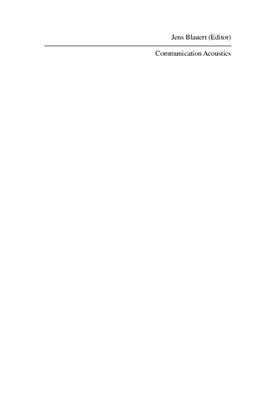Издательство Springer, 2005, -385 pp.
Communication Acoustics deals with those areas of acoustics which relate to the mode communication and information sciences and technologies. Due to the advent of digital signal processing and recording in acoustics, these areas have encountered an enormous upswing during the last four decades, whereby psychological and physiological knowledge is extensively exploited for technical applications. Communication-acoustical components can be found in various systems in communication technology, as either standalone systems or embedded components.
Since a comprehensive handbook on Communication Acoustics is not yet available, this volume tries to fill the gap by providing a collection of review articles covering some of the most relevant areas of the field. The articles are written with the goal in mind of providing students with comprehensive introductions and offer numerous references to relevant literature. Besides its usefulness as a textbook, this book will also be a source of valuable information for those who want to improve or refresh their knowledge in the field of Communication Acoustics.
Analysis and Synthesis of Auditory Scenes.
Evolutionary Adaptations for Auditory Communication.
A Functional View on the Peripheral Human Hearing Organ.
Modelling of Binaural Hearing.
Audio-Visual Interaction in the Context of Multi-Media Applications.
Psycho-Acoustics and Sound Quality.
Quality of Transmitted Speech for Humans and Machines.
Assigning Meaning to Sounds – Semiotics in the Context of Product-Sound Design.
Binaural Technique – Basic Methods for Recording, Synthesis, and Reproduction.
Hearing-Aid Technology.
Auditory Virtual Environments.
The Evolution of Digital Audio Technology.
Speech Production – Acoustics, Models, and Applications.
Speech and Audio Coding – Aiming at High Quality and Low Data Rates.
Communication Acoustics deals with those areas of acoustics which relate to the mode communication and information sciences and technologies. Due to the advent of digital signal processing and recording in acoustics, these areas have encountered an enormous upswing during the last four decades, whereby psychological and physiological knowledge is extensively exploited for technical applications. Communication-acoustical components can be found in various systems in communication technology, as either standalone systems or embedded components.
Since a comprehensive handbook on Communication Acoustics is not yet available, this volume tries to fill the gap by providing a collection of review articles covering some of the most relevant areas of the field. The articles are written with the goal in mind of providing students with comprehensive introductions and offer numerous references to relevant literature. Besides its usefulness as a textbook, this book will also be a source of valuable information for those who want to improve or refresh their knowledge in the field of Communication Acoustics.
Analysis and Synthesis of Auditory Scenes.
Evolutionary Adaptations for Auditory Communication.
A Functional View on the Peripheral Human Hearing Organ.
Modelling of Binaural Hearing.
Audio-Visual Interaction in the Context of Multi-Media Applications.
Psycho-Acoustics and Sound Quality.
Quality of Transmitted Speech for Humans and Machines.
Assigning Meaning to Sounds – Semiotics in the Context of Product-Sound Design.
Binaural Technique – Basic Methods for Recording, Synthesis, and Reproduction.
Hearing-Aid Technology.
Auditory Virtual Environments.
The Evolution of Digital Audio Technology.
Speech Production – Acoustics, Models, and Applications.
Speech and Audio Coding – Aiming at High Quality and Low Data Rates.

